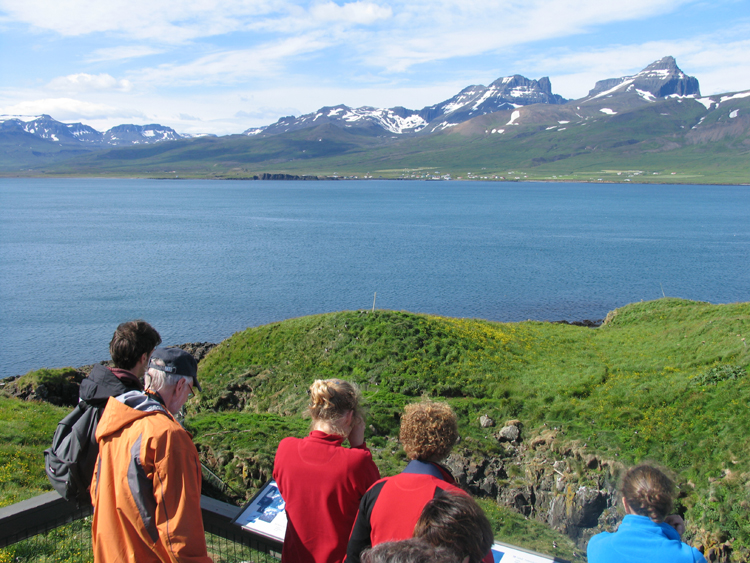Kittiwake
 The Black-legged Kittiwake (Rissa tridactyla), usually known simply as Kittiwake in English, is a common seabird in Iceland. It takes its name from its trisyllabic call: ki-ti-waak! It is called rita in Icelandic, ride in Danish, krykkje in Norwegian, tretåig mås in Swedish, Dreizenhenmöwe in German and moutte tridactyle in French. The Kittiwake is similar in appearance to the Common Gull but has blackish legs instead of yellow-green on the Common Gull. The European Kittiwake population numbers approximately 2.1 million to 3 million pairs, and at least 630,000 pairs are thought to breed in Iceland. Several Kittiwake colonies are known in eastern Iceland and isolated pairs probably breed widely along the coast. Research indicates that the east coast population has shrunk between surveys carried out in 1986-1999 and 2005, dropping from 80,000 nests to 20,000 nests. This decrease is thought to be related to a lack of food. The Kittiwake colony on Papey declined from 10,000 pairs in 1961 to 2,400 pairs in 1996.
The Black-legged Kittiwake (Rissa tridactyla), usually known simply as Kittiwake in English, is a common seabird in Iceland. It takes its name from its trisyllabic call: ki-ti-waak! It is called rita in Icelandic, ride in Danish, krykkje in Norwegian, tretåig mås in Swedish, Dreizenhenmöwe in German and moutte tridactyle in French. The Kittiwake is similar in appearance to the Common Gull but has blackish legs instead of yellow-green on the Common Gull. The European Kittiwake population numbers approximately 2.1 million to 3 million pairs, and at least 630,000 pairs are thought to breed in Iceland. Several Kittiwake colonies are known in eastern Iceland and isolated pairs probably breed widely along the coast. Research indicates that the east coast population has shrunk between surveys carried out in 1986-1999 and 2005, dropping from 80,000 nests to 20,000 nests. This decrease is thought to be related to a lack of food. The Kittiwake colony on Papey declined from 10,000 pairs in 1961 to 2,400 pairs in 1996.
 Kittiwakes lay from one to three eggs, but usually two. The eggs are laid in May and early June. Nests are generally built on narrow ledges on cliffs. A mixture of plant material from the sea and land, largely grass and moss, is used as nesting material. The colony at Hafnarhólmi is typical for the species. It has declined in number over the last 10-15 years from 500 pairs to 100-200 pairs.
Kittiwakes lay from one to three eggs, but usually two. The eggs are laid in May and early June. Nests are generally built on narrow ledges on cliffs. A mixture of plant material from the sea and land, largely grass and moss, is used as nesting material. The colony at Hafnarhólmi is typical for the species. It has declined in number over the last 10-15 years from 500 pairs to 100-200 pairs.
Large flocks of Kittiwakes can sometimes be seen in fresh water, estuaries and lagoons where they gather to bathe. They are a common sight, for example, by the bridge over the river Fjarðará in Borgarfjörður. Breeding colonies are very noisy places and the sound (and smell!) of a bird cliff is a memorable experience.
Kittiwakes are sometimes hunted and their eggs taken for food. According to the Environment Agency of Iceland between 354 and 2,324 Kittiwakes have been hunted annually in Iceland in recent years, but Kittiwake hunting is becoming less common.
Kittiwakes mainly feed on fish but, like Arctic Skuas and Great Skuas, they often rob other birds of their food. Outside the breeding season they are usually found at sea.
Kittiwakes can occasionally be seen far inland, many miles from their breeding grounds. Sometimes they head inland to seek fresh water in which to bathe, but they are also driven inland in stormy weather.
